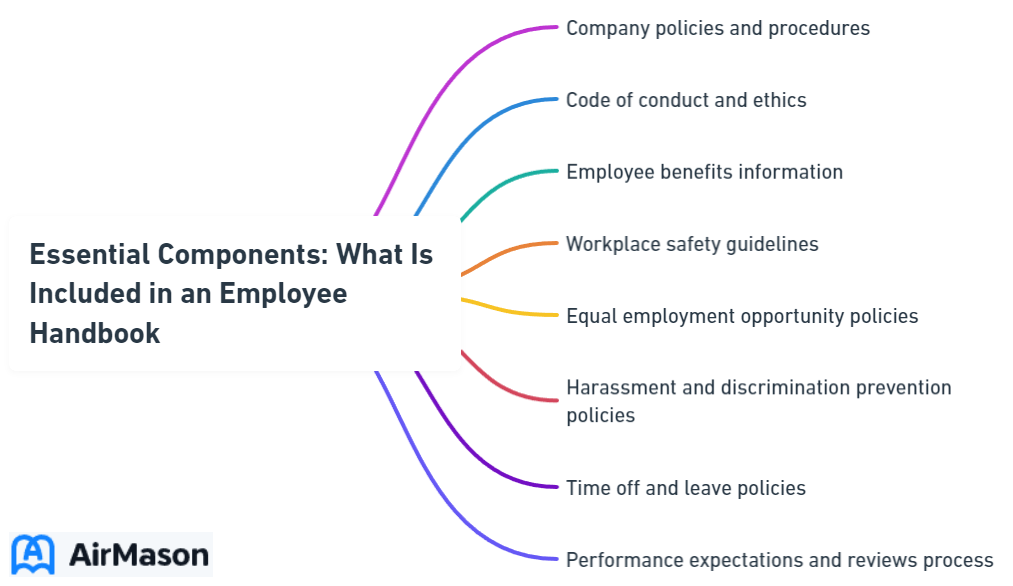
What is included in an employee handbook? This question is on the minds of employers and HR professionals looking to provide clarity and guidance to their team. An effective handbook includes clear policies, cultural guidelines, and outlines legalities – all crucial for setting expectations and maintaining compliance. Let’s dive into the key elements that form the spine of an employee handbook, preparing you to curate a guide that communicates everything employees need to know.
Key Takeaways
- An employee handbook is fundamental for delineating a company’s mission, vision, values, and culture, guiding employee behavior and fostering a unified organizational focus.
- Handbooks must include legal and compliance sections, ensuring the company’s policies align with employment laws like FMLA, FLSA, EEO, and OSHA to minimize legal vulnerabilities and clarify employment relationships.
- Comprehensive coverage of workplace policies, employee benefits, performance management, conflict resolution, and acknowledgment of receipt in the handbook ensures clarity on company expectations and supports employee engagement and development.
The Foundation: Company Mission, Vision, and Values

Consider a ship sailing without a compass—it’s directionless. Much like this, a company lacking a clearly defined mission, vision, and values can result in employees feeling disconnected and disoriented. Approximately 70% of employees define their sense of purpose by their work, making the inclusion of a company’s mission, vision, and values essential in an employee handbook. Highlighting these elements firmly communicates your company’s essence, offering a unified focus for all members of the organization.
But remember, it’s not enough to simply state them; your company must actively live by these principles to prevent creating a workforce of disengaged employees.
Company History and Culture
The journey of your company, its milestones, and cultural values, when shared, can serve as a source of pride and motivation for your existing employees. Incorporating this history in your employee handbook serves a dual purpose—it welcomes new employees and reaffirms your company values.
This connection with the organization’s journey helps to cultivate a supportive and inclusive culture, emphasizing open communication and development opportunities.

Leadership Message
A welcome message from the CEO in the handbook is like a warm handshake at the entry of your company’s world. This message instills a sense of belonging, demonstrating to employees that they are valued and the company’s leadership is personally invested in their well-being.
This personal touch, combined with a touch of optimism for the future, humanizes your company’s leadership, fostering a sense of trust and camaraderie.
Employee Policies Handbook
The Employee Policies Handbook serves as a comprehensive guide outlining the expectations, rules, and regulations governing employee conduct within an organization. This handbook is designed to provide employees with clarity on various workplace policies, including but not limited to, code of conduct, disciplinary procedures, and benefits eligibility. By familiarizing themselves with the contents of the Employee Policies Handbook, employees can gain a better understanding of their rights and responsibilities in the workplace. Moreover, the handbook serves as a reference point for managers and HR personnel when addressing employee concerns or enforcing company policies. Regular updates to the handbook ensure that it remains relevant and aligned with any changes in laws or company practices, fostering a transparent and compliant work environment. Overall, the Employee Policies Handbook plays a crucial role in promoting consistency, fairness, and compliance across all levels of the organization.
Legal Obligations and Compliance

While a company’s culture, values, and leadership messages are the heart of the employee handbook, legal obligations and compliance are its backbone. It is vital that your employee handbooks comply with all pertinent employment laws, including:
- Family and Medical Leave Act (FMLA)
- Fair Labor Standards Act (FLSA)
- Equal Employment Opportunity (EEO) laws
- Occupational Safety and Health Administration (OSHA) regulations
Compliance with legal requirements, often guided by an employment attorney, minimizes potential future legal threats and elucidates the employment relationship.
Equal Employment Opportunity Statement
Inclusion is not just a buzzword; it’s a statement of your company’s commitment to fostering a diverse and inclusive work environment. Incorporating an Equal Employment Opportunity (EEO) statement in your handbook is a crucial step towards legal compliance and warding off potential discrimination lawsuits.
This statement should be well-defined, accompanied by actionable steps and accountability measures within the organization to support its effective enforcement.
Fair Labor Standards Act and Wage Policies
Your employees’ time and hard work are valuable assets to your company, and they should be compensated fairly. That’s where the Fair Labor Standards Act (FLSA) comes into play. Your handbook should unambiguously communicate the company’s adherence to FLSA’s minimum wage requirements, exemptions, and overtime policies.
An employment agreement should also guide your employees about the expectations around meals, breaks, and overtime, ensuring clarity and fairness in employment policies, including wage policies.
Family and Medical Leave Act
Life happens. Whether it’s the birth of a child, a family illness, or personal health issues, employees should feel secure knowing that their jobs are protected during such times. The Family and Medical Leave Act (FMLA) provides this security. Ensure your employee handbook comprehensively delineates FMLA eligibility, coverage, and procedures, encompassing the process to request leave.
This reassures your employees that they have the company’s support during challenging times.
Workplace Policies and Procedures

Just like a well-orchestrated symphony, a harmonious workplace relies on everyone knowing their part and playing it well. Company policies and procedures serve as the sheet music for your company’s symphony. These guidelines, ranging from code of conduct to leave policies, provide clear instructions for employees on what is expected and acceptable. They promote work-life balance and create a safe, ergonomic work environment, all in accordance with the company policy.
Code of Conduct
The Code of Conduct in your employee handbook sets the rhythm for your company’s symphony. It outlines clear expectations for employee behavior and management within the company, ensuring everyone understands what is considered acceptable and unacceptable. And to maintain fairness and clarity, the handbook must clarify the consequences of violating the code of conduct, including outlining potential disciplinary actions that could lead to termination of employment.
Dress Code and Appearance
Just as each symphony has its own dress code, so does your company. Your employee handbook should clearly state this dress code policy, including guidelines on acceptable work attire, grooming standards, and any requirements for safety gear or uniforms. This ensures your employees understand the wardrobe expectations at all times and helps maintain a professional work environment.
Communication and Electronic Device Usage
In the digital age, the appropriate use of company communication tools and electronic devices is a key note in your company’s symphony. Your employee handbook should outline these guidelines, including expectations around privacy and monitoring of these tools by the company. Establishing unambiguous guidelines regarding personal use of electronic devices during work hours and the utilization of company devices for personal purposes is essential to maintain productivity and professionalism.
What is an Employee Handbook?
An employee handbook is a comprehensive document provided by employers to employees, outlining company policies, procedures, expectations, and guidelines. It serves as a vital resource for both employers and employees, clarifying rights, responsibilities, and procedures within the organization. Typically, it covers topics such as company culture, code of conduct, benefits, safety protocols, and disciplinary procedures. The handbook not only communicates the company’s values and expectations but also ensures consistency in how policies are implemented and enforced across the organization. Additionally, it can serve as a reference point for employees to understand their rights and responsibilities in various situations, fostering a transparent and harmonious work environment.
Employee Benefits and Compensation

Now that we’ve discussed the responsibilities and expectations, let’s talk about the rewards. Employee Benefits and Compensation are not just legal obligations, but also an expression of your company’s commitment to its employees. Your handbook should concisely communicate the following:
- Pay structure
- Payment frequency
- Overtime policy
- Differentiation between exempt/nonexempt and full-time/part-time employees
Health and Wellness Benefits
Your employees’ health and wellness should be a top priority. Your handbook should detail healthcare coverage options and wellness programs, emphasizing your company’s commitment to promoting physical health.
Offering incentives such as lower insurance premiums or bonuses can motivate employees to participate in wellness programs and meet health goals.
Paid Time Off and Leave Policies
Time off is not a luxury; it’s a necessity for maintaining a healthy work-life balance. Your handbook should clarify PTO accrual, how to schedule time off, and the types of leave available such as bereavement and sick leave.
Including provisions for nursing mothers according to the FLSA, such as reasonable break times and private spaces for breast milk pumping, shows your company’s support for working mothers.
Retirement Plans and Financial Benefits
Finally, your employees’ futures matter. Providing information on retirement plans, stock options, and other financial benefits in your handbook reinforces transparency and assists employees in understanding the full value of their compensation package. This helps them make informed decisions and plan for their financial future post-retirement.
What to Include in Employee Handbook
When determining what to include in an employee handbook, it’s crucial to cover essential policies and procedures that govern the workplace environment. Start with a comprehensive overview of company culture, mission, and values to set the tone for expectations. Next, address employment policies such as work hours, attendance, and dress code to ensure clarity and consistency among employees. It’s also essential to outline policies regarding employee conduct, including disciplinary procedures and code of ethics. Additionally, include information on employee benefits, such as health insurance, retirement plans, and paid time off, to keep employees informed about their entitlements. Finally, consider adding sections on safety protocols, confidentiality agreements, and any legal disclaimers to protect both the company and its employees.
Performance Management and Career Development

Once the notes of employee rights and obligations have been played, it’s time for the symphony of personal growth and career development to take center stage. Your handbook should comprehensively detail performance evaluation processes, career trajectories, and opportunities for development, as well as the management of each employee’s personnel file. This helps set clear expectations and provides a roadmap for employees to excel in their roles.
Performance Reviews and Feedback
Performance reviews are like the rehearsals of your company’s symphony. They help fine-tune your employees’ skills and align their performance with your company’s mission and values.
Your handbook should clearly outline how and when performance reviews will take place, enhancing transparency and contributing to employee development.
Promotions, Raises, and Recognition
A standing ovation for a well-played symphony motivates the orchestra. Similarly, promotions, raises, and recognitions serve as positive reinforcement for your employees’ hard work and dedication. Your handbook should clearly detail the organization’s criteria for promotions and raises, ensuring a fair and merit-based process.
Training and Professional Development
Every symphony requires continuous practice and learning. Similarly, ongoing training and professional development are vital for your employees to keep improving their skills and stay updated with industry trends.
Your handbook should highlight opportunities for skill-building, coaching, and ongoing education, fostering a culture of continuous learning.
Reporting Procedures and Conflict Resolution
Even in the best symphony, conflicts can arise. It’s how they’re resolved that makes all the difference. Your handbook should establish clear processes for reporting misconduct and resolving conflicts in the workplace.
This helps maintain a positive work environment and ensures that your employees feel heard and respected.
Anti-Harassment and Non-Discrimination Policies
A symphony celebrates harmony, not discord. In the same vein, your company should have zero tolerance for harassment, including sexual harassment, and discrimination. Your handbook should explicitly define harassment and lay out procedures for reporting and addressing incidents.
This promotes a safe and respectful work environment for all employees.
Whistleblower Protection
Courage to speak up against wrongdoing is like the bold trumpet blast in a symphony. It demands attention and action.
Your handbook should elaborate on your company’s whistleblower policy and protections, fostering an environment where employees can report misconduct, including unfair treatment claims, without apprehension of retaliation.
Grievance and Dispute Resolution
In a symphony, every note matters. Similarly, every employee’s voice matters in your company. Your handbook should lay out methods for addressing employee grievances and settling disputes. This ensures that any issues are promptly addressed and resolved to maintain a harmonious work environment.
Employee Acknowledgment and Handbook Updates
Just as a symphony ends with a resounding finale, the reader is led to the final section of our guide – Employee Acknowledgment and Handbook Updates. This section ensures that employees acknowledge receipt and understanding of the handbook and highlights the importance of keeping the handbook updated to stay aligned with evolving employment laws and company practices.
Employee Acknowledgment Receipt
The finale begins with the Employee Acknowledgment Receipt. This acts as the employees’ verification of having read and comprehended the handbook, bolstering legal protection and minimizing liability.
It’s a vital step in ensuring that your employees are fully aware of their rights and responsibilities.
Regular Review and Updates
As a symphony undergoes refinements over time, your handbook should also adapt to stay pertinent and compliant. Frequent reviews and updates are essential to guarantee it remains in line with evolving employment laws and company practices.
This ensures your effective employee handbook, also known as the employee manual, continues to be a reliable guide for your employees.
Summary
So, we’ve journeyed through the various movements of our symphony – the employee handbook. From understanding the company’s mission and values, to learning about legal compliance, workplace policies, benefits, performance management, reporting procedures, and finally, acknowledgment and updates. Just as a symphony resonates in the hearts of the audience long after the last note, a well-crafted employee handbook leaves a lasting impact on your employees, resonating your company’s values, culture, and commitment towards them.
Frequently Asked Questions
Which sections in the employee handbook would be most useful?
The most useful sections in the employee handbook would be leave, performance, appropriate use, conduct & company policy, discipline & termination, glossary, and agreement. You can refer to these sections for essential information regarding your role and responsibilities in the company.
Which of the following is included in the employee handbook?
The employee handbook typically includes company behavior policies, such as employee expectations, no smoking policy, dress code, attendance policy, use of company property policy, and substance abuse policy. Make sure to refer to the specific handbook for details.
What would not be included in an employee handbook?
Employee handbooks typically do not include region-specific policies such as overtime, meal and rest breaks, or sick time that may vary across different states.
What must be in an employee handbook?
An employee handbook should include information about employees’ rights under relevant employment laws, the employment relationship, and a code of conduct. It should also cover details about payment, work schedules, time off, overtime, and business expense reimbursement.
Why is it important to include the company’s mission, vision, and values in the employee handbook?
Including the company’s mission, vision, and values in the employee handbook is important because they provide a clear understanding of what the company stands for and guide employee behavior.
Disclaimer:
Please be aware that the content on this page has been generated by using artificial intelligence language models and may contain errors, inconsistencies, or outdated information.
It is provided as-is without any warranties or guarantees of accuracy. We strongly recommend using this content as a starting point for further research. We disclaim any liability for damages or losses resulting from the use or reliance on this content.